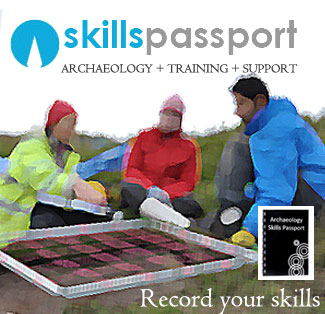Site formation is a basic building block of archaeology: it is by analysis of this sequence through excavation that permits interpretation, which should in turn lead to discussion and understanding. Main forms are Material Activity or Construction, Deposition, Re-deposition, Natural action or Decay.
You should be able to explain either verbally or in written form the process by which a specific context was derived.
PRINCIPLE: Understand the process of site formation, including fills, layers, structures or natural deposits.
Identifying and recording sediments
PRINCIPLE: Have a basic grasp of various sediment types, and the methods of recording elements such as colour, composition, inclusions, consistency etc.
- Novice – Is able to recognise the basic types of sediment, but finds difficulty in differentiation of more complex or closely related sediments and needs all records checked.
- Competent – Can recognise the recording method for each sediment type and is able to record with confidence, with records verified by a supervisor.
- Proficient – Has no problem in preparing an accurate record of the sediment, which needs no further supervisory input other than standard record checks.
Interpreting depositional processes
PRINCIPLE: Have a basic understanding of the common site formation processes.
- Novice – Is able to understand the common formation processes such as soil and sediment formation, building decay and demolition as well as fills and other cultural modifiers.
- Competent – Is able to understand the various formation processes and interrelate the context units within a close discreet area.
- Proficient – Can confidently comprehend site formation processes and relate them on a temporal and spatial site wide level. Connecting various formation events to provide a structured and coherent narrative.
Professional tips:
With site formation, it is useful to create a narrative, into which each context and material find can be placed. Consider the most logical path for how the particular context has formed and why it has formed.
Remember that absence of material may be as telling as presence, the site narrative is an organic process that evolves as your excavate. Do not be afraid to catalogue your thoughts as your work, as this documents how you viewed the site formation at the time of discovery – it does not have to be right – only accurate.
The prominent processual archaeologist Lewis Binford highlighted the fact that the archaeological evidence left at a site may not be entirely indicative of the historical events that actually took place there. Using an ethnoarchaeological comparison, he looked at how hunters amongst the Nunamiut Iñupiat of north central Alaska spent a great deal of time in a certain area simply waiting for prey to arrive there, and that during this period, they undertook other tasks to pass the time, such as the carving of various objects, including a wooden mould for a mask, a horn spoon and an ivory needle, as well as repairing a skin pouch and a pair of caribou skin socks. Binford notes that all of these activities would have left evidence in the archaeological record, but that none of them would provide evidence for the primary reason that the hunters were in the area; to wait for prey. As he remarked, waiting for animals to hunt “represented 24% of the total manhours of activity recorded; yet there is no recognisable archaeological consequences of this behaviour. No tools left on the site were used, and there were no immediate material “byproducts” of the “primary” activity. All of the other activities conducted at the site were essentially boredom reducers.”[1]
[1] Binford, Lewis (1978). “Dimensional analysis of behaviour & site structure: learning from an Eskimo hunting stand”. American Antiquity. 40: 335.


